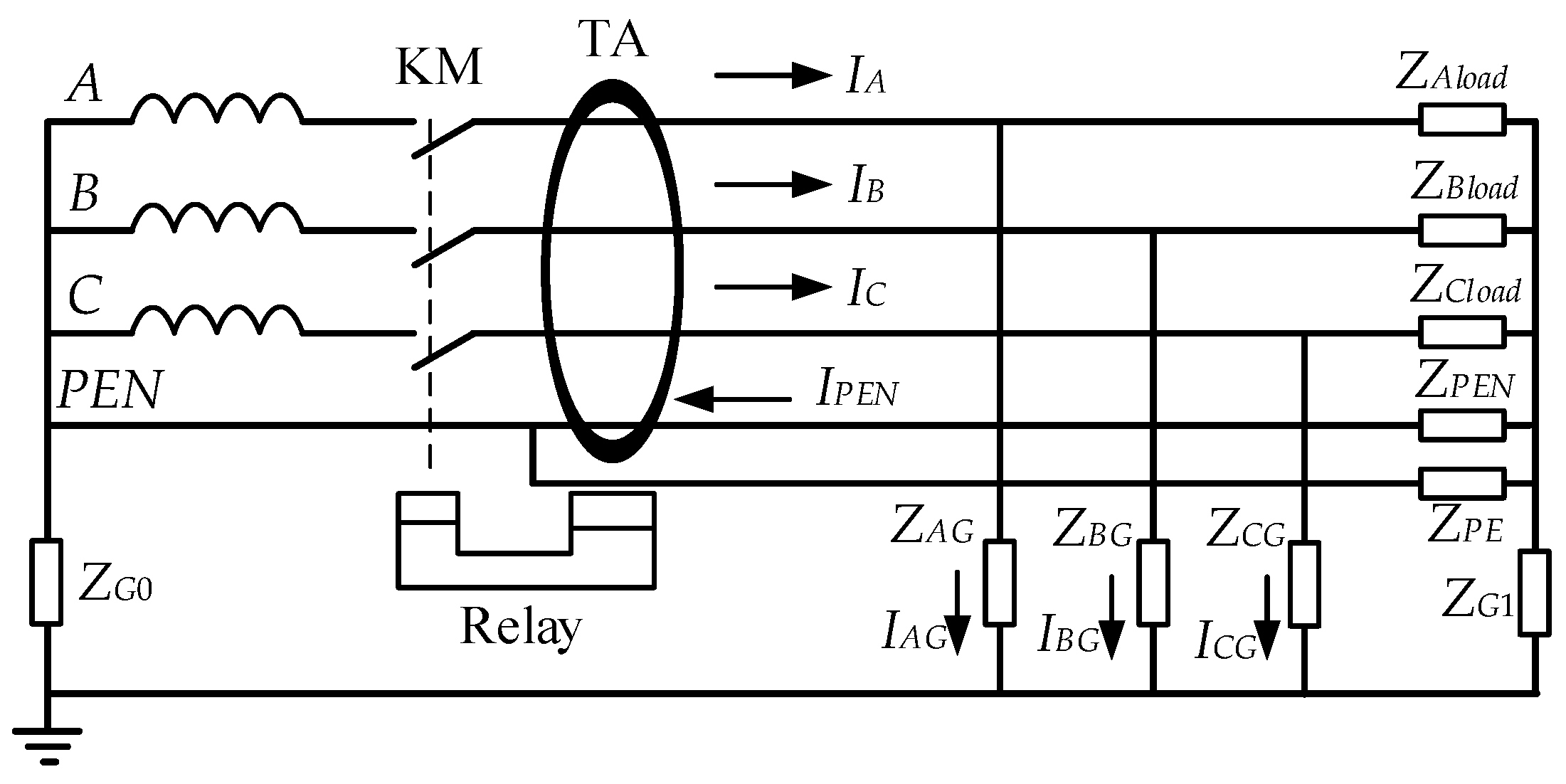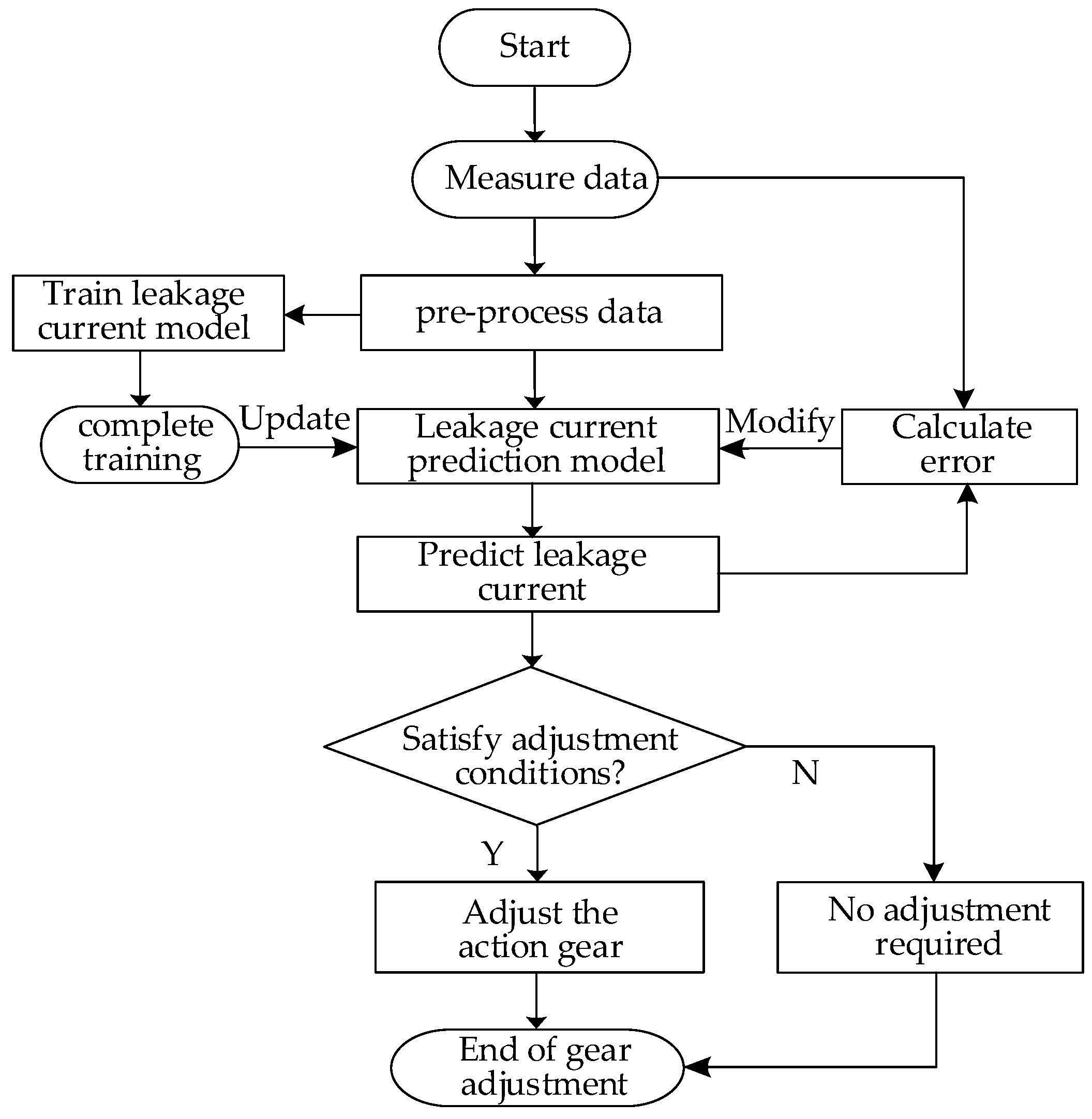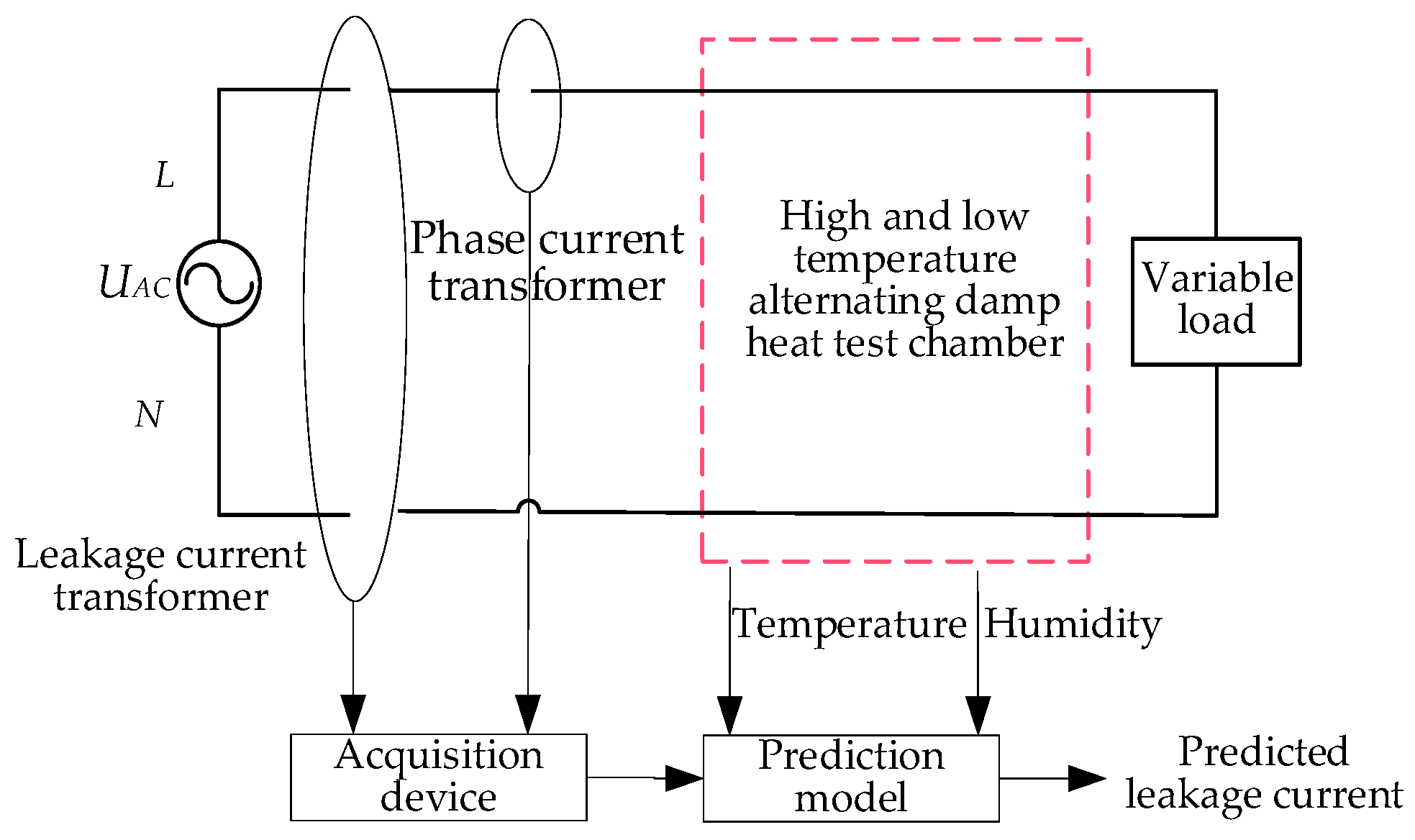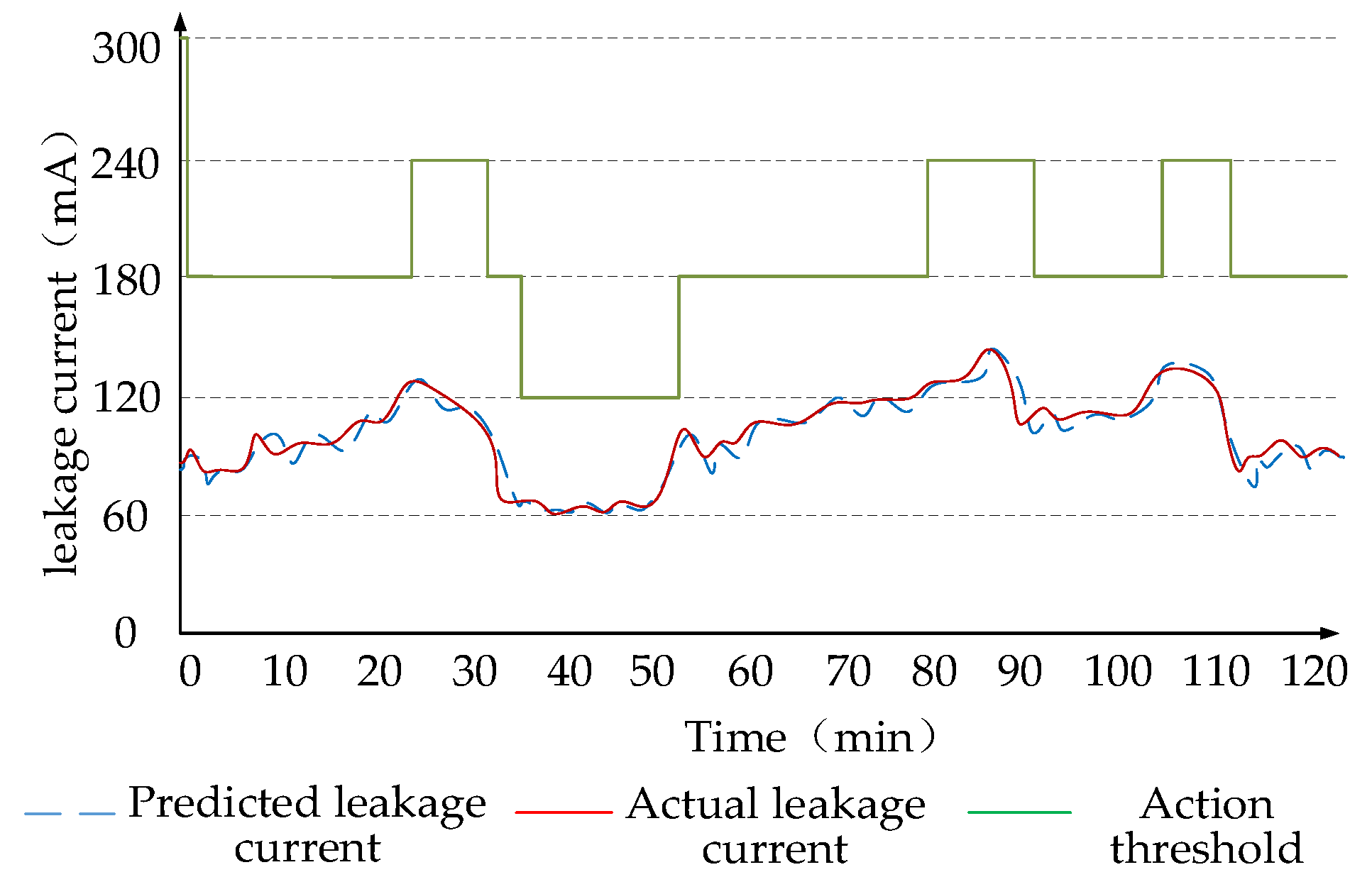Adaptive Leakage Protection for Low-Voltage Distribution Systems Based on SSA-BP Neural Network
Abstract
1. Introduction
2. Principle of Normal Leakage Current Variation
3. Normal Leakage Current Prediction Model
3.1. Principle of Adaptive Action Threshold Adjustment
3.2. Sparrow Algorithm Optimizes BP Neural Network Prediction
3.3. Data Pre-Processing
3.4. Prediction Model Training
4. Adaptive Leakage Protection Strategy
5. Experimental Verification
5.1. Leakage Current Prediction Experiment
5.2. Adaptive Protection Test
- (1)
- The leakage action threshold automatically selects the highest level at the beginning of the algorithm running, that is, the 300 mA gear. However, the leakage current at this time is 83 mA, which is less than the lower limit of the highest gear (150 mA), and there is no situation exceeding [70, 120] within the next 1 min, so the leakage action threshold is lowered to the 180 mA gear after 1 min.
- (2)
- During the period of 1~23 min, the predicted leakage current does not exceed the leakage interval of [70, 120], and the protection action threshold remains unchanged.
- (3)
- At 23 min, the leakage current was 121 mA, which was greater than the upper limit of the original leakage interval (120 mA), and did not return to the original interval within 1 min. In this case, the gear upward adjustment condition is met, and the action gear is adjusted to the fourth gear, which corresponds to a change in the action threshold to 240 mA.
- (4)
- In the period of 24~32 min, the predicted leakage current does not exceed the interval of [110, 160], and the protection action threshold remains unchanged.
- (5)
- At 32 min, the leakage current value was 109 mA, which was less than the lower limit of the original interval of 110 mA, and did not return to the original interval within 1 min. In this instance, the action gear was adjusted to the third gear. That is, the action threshold is 180 mA. Afterwards, gear shifting continues to be performed according to the rules of Equation (19).
5.3. Compared with Other Methods
6. Conclusions
- (1)
- In this paper, the influencing factors of normal leakage current change are analyzed, and it is found that the normal leakage current of the line is affected by the environmental temperature, humidity, aging, and line voltage drop, and that the normal leakage current may change greatly or even double under multi-factor extreme conditions.
- (2)
- The SSA-BP neural network is used to build a prediction model of normal leakage current, and the model is trained based on the current and historical data collected. In the leakage protection experiment, the prediction accuracy is more than 95%, and the operation rate and action accuracy of the leakage protection device are more than 90%. It is verified that the predicted results can be used as a reference for the development trend of a normal leakage current.
- (3)
- The predicted leakage current is used to adjust the protection action threshold in advance, which improves the action accuracy of the leakage protector. It not only ensures the operation availability of the leakage protector, but also makes the leakage protector more sensitive in identifying the high-resistance ground leakage fault. In future work, we will explore the impact of input data quality on prediction accuracy and how to improve the accuracy of leakage prediction by improving data quality.
Author Contributions
Funding
Institutional Review Board Statement
Informed Consent Statement
Data Availability Statement
Conflicts of Interest
References
- Wang, Z.; Zeng, X.; Yu, K.; Li, Z.; Zhao, Z.; Zhuo, C.; Li, L. A leakage protection method for low-voltage power supply systems based on flexible regulation of the neutral point voltage. Int. J. Electr. Power Energy Syst. 2023, 151, 109157. [Google Scholar] [CrossRef]
- Liang, Y. New Idea of the Multilevel Leakage Protection in Underground LV Distribution Networks. Adv. Mater. Res. 2011, 383–390, 1481–1487. [Google Scholar] [CrossRef]
- Zhang, X.; Han, X. Study on a New Low-Voltage Residual Current Protective System. Adv. Mater. Res. 2013, 694–697, 822–825. [Google Scholar] [CrossRef]
- Cheng, D.; Zhang, B.; Xiong, S.; Xie, Z.; Xue, Z. Residual Current Detection Prototype and Simulation Method in Low Voltage DC System. IEEE Access 2022, 10, 51100–51109. [Google Scholar] [CrossRef]
- Fabio, F. High-Frequency Behavior of Residual Current Devices. IEEE Trans. Power Deliv. 2012, 27, 1629–1635. [Google Scholar]
- IEC Standard 60947-2; Effects of Current on Human Beings and Livestock—Part 2: Circuit Breaker Incorporating Residual Current Protection. IEC: Geneva, Switzerland, 2009.
- IEC Standard 60755; General Requirements for Residual Current Operated Protective Devices. IEC: Geneva, Switzerland, 2008.
- Li, K.; Lin, J.; Niu, F.; Wang, Y.; Li, Q.; Guo, Z.; Wu, Y. A Novel Fault Leakage Current Detection Method with Protection Deadzone Elimination. IEEE Trans. Instrum. Meas. 2021, 70, 3505009. [Google Scholar] [CrossRef]
- Sutaria, J.; Espin-Delgado, A.; Ronnberg, S. Measurements and modeling of the frequency behavior of residual current devices- from 4 Hz to 40 kHz. Electr. Power Syst. Res. 2022, 209, 108052. [Google Scholar] [CrossRef]
- Möller, F.; Blanco, A.M.; Meyer, J. Characteristic leakage current of household devices and their impact on the tripping behaviour of residual current devices. Electr. Power Syst. Res. 2023, 214, 108832. [Google Scholar] [CrossRef]
- Liyana, I.; Bin Hanaffi, F.; Bin Hairi, M.H. A Study on Residual Current Device Nuisance Tripping Due to Grounding Resistance Value. In Proceedings of the 2019 5th International Conference on Electrical, Control and Computer Engineering (ICECCE), Kuantan, Pahang, Malaysia, 29 July 2019; Volume 632, pp. 717–723. [Google Scholar]
- Czapp, S. Testing Sensitivity of A-Type Residual Current Devices to Earth Fault Currents with Harmonics. Sensors 2020, 20, 2044. [Google Scholar] [CrossRef]
- Czapp, S.; Tariq, H. Behavior of residual current devices at frequencies up to 50 kHz. Energies 2021, 14, 1785. [Google Scholar] [CrossRef]
- Han, X.; Sheng, W.; Du, S.; Su, J.; Liu, G. Novel protection scheme for residual current device-based electric fault time detection and touch current identification. IET Gener. Transmiss. Distrib. 2017, 11, 2478–2488. [Google Scholar] [CrossRef]
- Han, X.; Du, S.; Li, Z.; Sun, L. Diagnosis of electric shock fault based on time-frequency singular value spectrum of leakage current and fuzzy clustering. Nongye Gongcheng Xuebao/Trans. Chin. Soc. Agric. Eng. 2018, 34, 217–222. [Google Scholar]
- Jedsada, S.; Nattapan, T. Earth leakage current detection and identification scheme for a single-phase low-voltage electrical appliance system using frequency domain analysis. In Proceedings of the 2016 13th International Conference on Electrical Engineering/Electronics, Computer, Telecommunications and Information Technology (ECTICON), Chiang Mai, Thailand, 28 June–1 July 2016; Volume 1, pp. 1–4. [Google Scholar]
- Zhang, X.; Liu, Z.; Wang, Y.; Dou, Z.; Zhai, G.; Wei, Q. Residual Current Detection Method Based on Variational Modal Decomposition and Dynamic Fuzzy Neural Network. IEEE Access 2021, 9, 142925–142937. [Google Scholar] [CrossRef]
- Li, Y.; Xia, C.; Zhuang, Y.; Huang, S. Research on Residual Current Warning Technology Based on Big Data Analysis. In Proceedings of the 2021 International Conference on Power Electronics and Power Transmission (ICPEPT 2021), Xi’an, China, 15–17 October 2021; Volume 1, pp. 1–6. [Google Scholar]
- Li, C.; Su, J.; Du, H.; Xia, Y.; Zhang, J.; Zhang, L. Detecting model of electric shock signal based on wavelet analysis and BP neural network. Trans. CSAE 2010, 26 (Suppl. S2), 130–134. [Google Scholar]
- Bento, P.M.R.; Pombo, J.A.N.; Calado, M.R.A.; Mariano, S.J.P.S. A bat optimized neural network and wavelet transform approach for shortterm price forecasting. Appl. Energy 2018, 210, 88–97. [Google Scholar] [CrossRef]
- Behrends, H.; Millinger, D.; Weihs-Sedivy, W.; Javornik, A.; Roolfs, G.; Geißendörfer, S. Analysis of Residual Current Flows in Inverter Based Energy Systems Using Machine Learning Approaches. Energies 2022, 15, 582. [Google Scholar] [CrossRef]
- Huang, B.; Liu, L.; Zhang, H.; Li, Y.; Sun, Q. Distributed Optimal Economic Dispatch for Microgrids Considering Communication Delays. IEEE Trans. Syst. Man Cybern. Syst. 2019, 49, 1634–1642. [Google Scholar] [CrossRef]
- Dorahaki, S.; Dashti, R.; Shaker, H.R. Optimal Outage Management Model Considering Emergency Demand Response Programs for a Smart Distribution System. Appl. Sci. 2020, 10, 7406. [Google Scholar] [CrossRef]
- Dorahaki, S.; Rashidinejad, M.; Fatemi Ardestani, S.F.; Abdollahi, A.; Salehizadeh, M.R. An Integrated Model for Citizen Energy Communities and Renewable Energy Communities Based on Clean Energy Package: A Two-Stage Risk-Based Approach. Energy 2023, 277, 127727. [Google Scholar] [CrossRef]
- Huang, B.; Zheng, S.; Wang, R.; Wang, H.; Xiao, J.; Wang, P. Distributed Optimal Control of DC Microgrid Considering Balance of Charge State. IEEE Trans. Energy Convers. 2022, 37, 2162–2174. [Google Scholar] [CrossRef]
- Bhatia, K.; Darji, P.B.; Jariwala, H.R. Safety Analysis of TN-S and TN-C-S Earthing System. In Proceedings of the 2018 IEEE International Conference on Environment and Electrical Engineering and 2018 IEEE Industrial and Commercial Power Systems Europe (EEEIC/I&CPS Europe), Palermo, Italy, 12–15 June 2018; Volume 1, pp. 1–6. [Google Scholar]
- Bai, Y.; Luo, M.; Pang, F. An Algorithm for Solving Robot Inverse Kinematics Based on FOA Optimized BP Neural Network. Appl. Sci. 2021, 11, 7129. [Google Scholar] [CrossRef]
- Gong, M.; Liu, J.; Qin, A.; Zhao, K.; Tan, K. Evolving Deep Neural Networks via Cooperative Coevolution with Backpropagation. IEEE Trans. Neural Netw. Learn. Syst. 2021, 32, 420–434. [Google Scholar] [CrossRef] [PubMed]
- Tang, X.; Xu, B.; Xu, Z. Reactor Temperature Prediction Method Based on CPSO-RBF-BP Neural Network. Appl. Sci. 2023, 13, 3230. [Google Scholar] [CrossRef]
- Yan, P.; Shang, S.; Zhang, C. Research on the Processing of Coal Mine Water Source Data by Optimizing BP Neural Network Algorithm with Sparrow Search Algorithm. IEEE Access 2021, 9, 108718–108730. [Google Scholar] [CrossRef]
- Wang, Z.; Qin, J.; Hu, Z.; He, J.; Tang, D. Multi-Objective Antenna Design Based on BP Neural Network Surrogate Model Optimized by Improved Sparrow Search Algorithm. Appl. Sci. 2022, 12, 12543. [Google Scholar] [CrossRef]
- Huang, B.; Wang, Y.; Yang, C.; Li, Y.; Sun, Q. A Neurodynamic-Based Distributed Energy Management Approach for Integrated Local Energy Systems. Int. J. Electr. Power Energy Syst. 2021, 128, 106737. [Google Scholar] [CrossRef]
- Liu, Z.; Huang, B.; Hu, X.; Du, P.; Sun, Q. Blockchain-Based Renewable Energy Trading Using Information Entropy Theory. IEEE Trans. Netw. Sci. Eng. 2023. [Google Scholar] [CrossRef]
- Ualikhan, I.; Josif, B. Development of Control Algorithm for Adaptive Leakage Current Protection Devices’ Using Fuzzy Logic. Procedia Eng. 2015, 100, 666–671. [Google Scholar] [CrossRef][Green Version]








| Algorithm | MIRE | MARE | MSE |
|---|---|---|---|
| BP | 0.0086 | 1.0053 | 0.0411 |
| SSA-BP | 0.0017 | 0.1852 | 0.0095 |
Disclaimer/Publisher’s Note: The statements, opinions and data contained in all publications are solely those of the individual author(s) and contributor(s) and not of MDPI and/or the editor(s). MDPI and/or the editor(s) disclaim responsibility for any injury to people or property resulting from any ideas, methods, instructions or products referred to in the content. |
© 2023 by the authors. Licensee MDPI, Basel, Switzerland. This article is an open access article distributed under the terms and conditions of the Creative Commons Attribution (CC BY) license (https://creativecommons.org/licenses/by/4.0/).
Share and Cite
Liu, Z.; Yu, H.; Jin, W. Adaptive Leakage Protection for Low-Voltage Distribution Systems Based on SSA-BP Neural Network. Appl. Sci. 2023, 13, 9273. https://doi.org/10.3390/app13169273
Liu Z, Yu H, Jin W. Adaptive Leakage Protection for Low-Voltage Distribution Systems Based on SSA-BP Neural Network. Applied Sciences. 2023; 13(16):9273. https://doi.org/10.3390/app13169273
Chicago/Turabian StyleLiu, Zhenguo, Hai Yu, and Wei Jin. 2023. "Adaptive Leakage Protection for Low-Voltage Distribution Systems Based on SSA-BP Neural Network" Applied Sciences 13, no. 16: 9273. https://doi.org/10.3390/app13169273
APA StyleLiu, Z., Yu, H., & Jin, W. (2023). Adaptive Leakage Protection for Low-Voltage Distribution Systems Based on SSA-BP Neural Network. Applied Sciences, 13(16), 9273. https://doi.org/10.3390/app13169273






